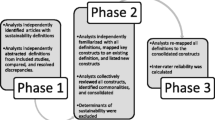Abstract
We have developed, tested, and successfully implemented an affordable, evidence-based, comprehensive cardiovascular disease risk-reduction program for use in primary and secondary prevention settings. The program is administered at hospitals, physician practices, cardiac rehabilitation programs, work sites, shopping malls, and health clubs. The program is also delivered from a call center using the telephone and the Internet. Program staff are guided by a computerized participant management and tracking system. Lifestyle management interventions are based on several behavior change models, primarily social learning theory, the stages of change model, and single concept learning theory. Typically, the program is administered entirely by non-physician healthcare professionals whose services are integrated with the care provided by the participants’ physicians. Outcome data have documented the clinical effectiveness of this innovative approach.
Similar content being viewed by others
References and Recommended Reading
Centers for Disease Control and Prevention: Mortality from coronary heart disease and acute myocardial infarction—United States, 1998. MMWR 2001, 50:90–93.
Cooper R, Cutler J, Desvigne-Nickens P, et al.: Trends and disparities in coronary disease, stroke, and other cardiovascular diseases in the United States. Findings of the National Conference on Cardiovascular Disease Prevention. Circulation 2000, 102:3137–3147.
Pearson TA, Peters TD: The treatment gap in coronary artery disease and heart failure; community standards and the post-discharge patient. Am J Cardiol 1997, 80:45H-52H.
Smith SC, Blair SN, Criqui MH, et al.: AHA consensus panel statement. Preventing heart attack and death in patients with coronary disease. Circulation 1995, 92:2–4.
American Heart Association: 2001 Heart and Stroke Statistical Update. Dallas: American Heart Association, 2000.
Gordon NF, Haskell WL: Comprehensive cardiovascular risk reduction in a cardiac rehabilitation setting. Am J Cardiol 1997, 80:69H-73H.
Pearson TA, Fuster V: 27th Bethesda Conference. Executive summary. J Am Coll Cardiol 1996, 27:961–963.
Gordon NF: Comprehensive cardiovascular disease risk reduction in the clinical setting. Coronary Artery Dis 1998, 9:731–735.
Loeppke RR: Intervention and managed care: the next generation. J Occup Environ Med 1995, 37:558–562.
Ockene IS, Ockene JK: Barriers to lifestyle change, and the need to develop an integrated approach to prevention. Cardiol Clin 1996, 14:159–169.
Wenger NK, Froelicher ES, Smith LK, et al.: Cardiac Rehabilitation as Secondary Prevention, Clinical Practice Guideline. Quick Reference Guide for Clinicians, No. 17. Rockville, MD: US Department of Health and Human Services, Public Health Service, Agency for Health Care Policy and Research and National Heart, Lung, and Blood Institute. AHCPR Pub. No. 96-0673. October, 1995.
Bairey Merz CN, Rozanski A: Remodeling cardiac rehabilitation into secondary prevention programs. Am Heart J 1996, 132:418–427.
Balady GJ, Ades PA, Comoss P, et al.: Core components of cardiac rehabilitation/secondary prevention programs. A statement for health care professionals from the American Heart Association and the American Association of Cardiovascular and Pulmonary Rehabilitation. Circulation 2000, 102:1069–1073.
Haskell WL, Alderman EL, Fair JM, et al.: Effects of intensive multiple risk factor reduction on coronary atherosclerosis and clinical cardiac events in men and women with coronary artery disease. The Stanford Coronary Risk Intervention Project (SCRIP). Circulation 1994, 89:975–990.
Gordon NF: Comprehensive cardiovascular disease risk management in clinical and community-based settings. Am Coll Sports Med Certified News 1998, 8:1–4.
16. Office of Counsel to the Inspector General: U.S. Department of Health and Human Services. OIG Advisory Opinion 00-4. D McCarty Thornton, Chief Counsel. Available at http://www.hhs.gov/progorg/oig/advopn/2000/ao00_4.htm.
Wilson PW, D’Agostino RB, Levy D, et al.: Prediction of coronary heart disease using risk factor categories. Circulation 1998, 97:1837–1847.
Grundy SM, Balady GJ, Criqui MH, et al.: Guide to primary prevention of cardiovascular diseases: a statement for health care professionals from the task force on risk reduction. Circulation 1997, 95:2329–2331.
Joint National Committee: The sixth report of the Joint National Committee on Prevention, Detection, Evaluation and Treatment of High Blood Pressure. Arch Intern Med 1997, 157:2413–2446.
Expert Panel on Detection, Evaluation, and Treatment of High Blood Cholesterol in Adults: Executive Summary of the Third Report of the National Cholesterol Education Program (NCEP) Expert Panel on Detection, Evaluation, and Treatment of High Blood Cholesterol in Adults (ATP III). JAMA 2001, 285:2486–2497.
American Diabetes Association: Clinical Practice Recommendations 2000. Diabetes Care 2000, S1–S112.
National Heart, Lung, and Blood Institute: Clinical Guidelines on the Identification, Evaluation, and Treatment of Overweight and Obesity in Adults. NIH Pub. No. 98 - 4083, 1998.
American College of Sports Medicine: ACSM’s Guidelines for Exercise Testing and Prescription, edn 6. Edited by Franklin BA, Whaley MH, Howley ET, et al. Philadelphia: Lippincott Williams and Wilkins; 2000.
American Association of Cardiovascular and Pulmonary Rehabilitation: Guidelines for Cardiac Rehabilitation and Secondary Prevention Programs. Champaign, IL: Human Kinetics Publishers; 1998.
Gordon NF, Scott CB, Levine BD: Comparison of single versus multiple lifestyle interventions: are the antihypertensive effects of exercise training and diet-induced weight loss additive? Am J Cardiol 1997, 79:763–767.
Contractor AS, Alexander LA, Blaschko EA, et al.: Effect of sequence of lifestyle intervention on select cardiovascular disease risk factors. Med Sci Sports Exerc 1999, 31:5239.
Gordon NF, English CD, Contractor A, et al.: Clinical effectiveness of three models for comprehensive cardiovascular disease risk reduction in lower risk patients with coronary artery disease. Circulation 2000, 102:18.
Gordon NF, English CD, Contractor A, et al.: Feasibility and clinical effectiveness of a neurologist supervised, nurse case managed stroke risk reduction program. Circulation 2000, 102:18.
Lafranchise EF, Widener WG, Franklin BA, et al.: Need for and clinical effectiveness of a neurologist supervised, nurse case managed stroke risk reduction program. Stroke 2001, 32:367.
Author information
Authors and Affiliations
Rights and permissions
About this article
Cite this article
Gordon, N.F., Salmon, R.D., Mitchell, B.S. et al. Innovative approaches to comprehensive cardiovascular disease risk reduction in clinical and community-based settings. Curr Atheroscler Rep 3, 498–506 (2001). https://doi.org/10.1007/s11883-001-0040-9
Issue Date:
DOI: https://doi.org/10.1007/s11883-001-0040-9




